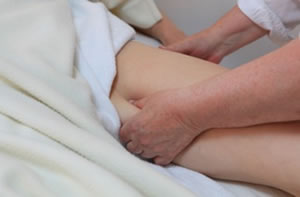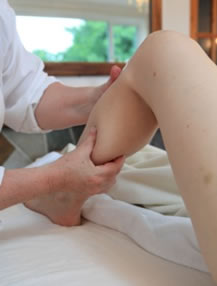Extract From “Between Psyche and Soma – Introduction to Biodynamic Psychology” ( DEEP-DRAINING) – By Gerda Boyesen

“Deep-Draining” on the ‘wing’ – shoulder girdle and scapula
“One of the first things that struck me was that the body literally “encapsulates” [1] emotions and stressful experiences by making the muscles so rigid that the contractions become chronic; the repressed emotion is held intact by the muscular tension itself. But by working methodically on these areas of permanent tension, the encapsulation dissolved and the repressed emotions of the stressful experiences “came back to life”, so to speak.
The process of emotional encapsulation is a fascinating and complex phenomenon, and one that played a central part in my research for many years. Not only does it explain the physical and vegetative process of repression, but it also helps to explain the associated psychodynamic process when repression is re-awakened during therapy. It provides the key to understanding the success of BülowHansen’s treatment.
Yet neither she nor my other colleagues were interested in discussing what actually took place in the body depths during and between the massage sessions. We learned the method, we followed the rules we were given, we got excellent results – and that was that. I was alone in asking these questions, exploring the method and theorising about the answers.
[1] We use the term “encapsulation” to designate the process of armouring or enclosing which keeps the energy static, as though encapsulated”.
Gerda Boyesen 1979

“Deep-Draining” on muscles in the inner thigh
“Deep-Draining” or “psycho-postural treatment” is a specialised psychotherapeutic massage technique developed by Gerda Boyesen based on training she received from the Norwegian physiotherapist Aadal Bulow Hansen. It is so named because it is designed to help the client’s natural elimination processes to drain excess nervous energetic fluid from the cells and tissues. If left in the body, this can lead to stasis and distension, as well as feelings of fullness and internal pressure.
Deep-draining is a systematic and structured treatment that is applied on the skeletal muscles and on the muscles involved in respiration and breathing. This is essential in order to loosen tension on the physical level. Originally this treatment was used mostly for people whose emotional energy was so strongly encapsulated within the muscles that they hardly experienced any feeling or emotion at all, neither pain nor pleasure. A person with such armouring is known in biodynamic terms as having a ‘stone’ structure.
The aim of the treatment is to dissolve the muscle armour and release this encapsulation, thus making the client’s emotional energy available to them again – usually first as sensations and later as emotions. Feelings can then be worked with using the biodynamic psychotherapy methods within the deep-draining context.

“Deep-Draining” on the calf muscles – lower leg

“Deep-draining” on hypo-tonic muscles – upper arm